
| Home | Deepsky Atlas | TheAstronews | Links | Solar System | ||||||

Hawaiian Astronomical SocietyConstellations: Taurus -- Sex Consummated, Sex Denied |
||||||||||
Another story about Taurus involves the seven daughters of Atlas, or in other versions, Pleione. The great hunter Orion took more than a passing interest in them. Atlas felt a rather old fashioned concern for his daughters, and asked Zeus to protect them. Zeus transformed the seven sisters into doves and placed them in the sky. When Orion followed them, Zeus placed a large bull between him and the seven new stars.
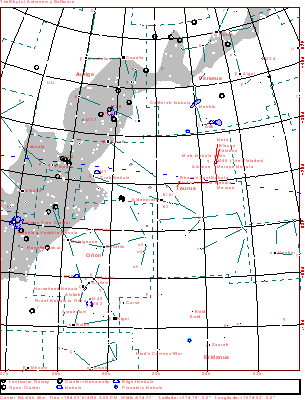
Click the map for a 916x1200 version of the above. Click here for a map better suited for use in the field.
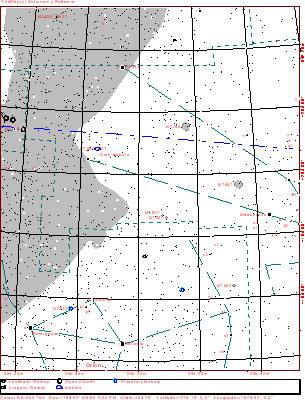
This a more detailed view of the constellation. The map displays stars to magnitude 10, and deepsky objects to magnitude 12. Click here for a map better suited for use in the field.
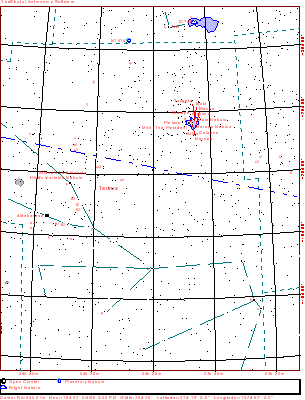
Click here for a map better suited for use in the field.
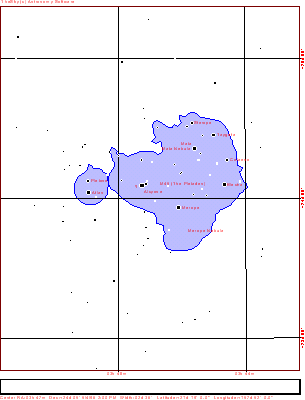
Click here for a map better suited for use in the field.
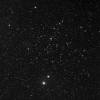 58k JPEG NGC1647 is an open cluster located 3.5° north-east of Aldebaran (Alpha Tauri). Dreyer calls it very large (40'), fairly bright (mag. 6.4), with about 25 stars between mags. 8-13. Binoculars just begin to resolve this cluster. Very pretty in a low power field. Two stars, one bright (mag.6) orange (SAO 94112), the other not so bright (mag. 7.8) an orange (SAO 94110), sit at the southern edge, giving a nice contrast. Image from the Digital Sky Survey. 58k JPEG NGC1647 is an open cluster located 3.5° north-east of Aldebaran (Alpha Tauri). Dreyer calls it very large (40'), fairly bright (mag. 6.4), with about 25 stars between mags. 8-13. Binoculars just begin to resolve this cluster. Very pretty in a low power field. Two stars, one bright (mag.6) orange (SAO 94112), the other not so bright (mag. 7.8) an orange (SAO 94110), sit at the southern edge, giving a nice contrast. Image from the Digital Sky Survey.
|
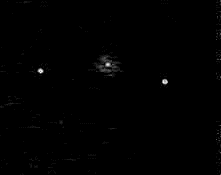 NGC1514 is a planetary nebula located 1.8° NNE of Psi Tauri on the Perseus border. The HAS map locates it in Perseus, but that appears to be an error of TheSky, which placed the boundary a little too far south. Central star is mag. 9.1, while the nebulosity extends over 3', and shines at a dim mag. 11. NGC1514 is a planetary nebula located 1.8° NNE of Psi Tauri on the Perseus border. The HAS map locates it in Perseus, but that appears to be an error of TheSky, which placed the boundary a little too far south. Central star is mag. 9.1, while the nebulosity extends over 3', and shines at a dim mag. 11.
A description by Eric Greene: "This seems to be one of the least observed of the large, bright planetary nebulae. It is very large and ring shaped around a mag 10 star. I spent a long time looking for it before finally spotting it at the Blue Ridge Parkway star gaze in 1989. I kept walking over the planetary without seeing it since it was so large. Look for 3 mag 10 stars in a line across your field of view and the nebula is around the middle star. While easy in really dark skies, it becomes a much more difficult object with light pollution or haze. A UHC or O-III filter and around 110 pop it easily into view." Sketch by Scott Davis.
|
M1 (NGC1952) is a patch of nebulosity from a supernova explosion observed in 1054 C.E. (formerly A.D.). You can find it by aiming 1.2° NW of Zeta Tauri. Shining at mag 8.4, and covering 6' of the sky, Dreyer calls it "very bright." Dreyer was a tad optimistic. It is somewhat elongated in position angle 135°.
| Map | Printable Map | More info. |
 41k GIF. The Crab Nebula is shown in a three-color reconstruction from BVR CCD images taken in 1993 with the 1.1m Hall telescope at Lowell Observatory. More images can be found at the University of Alabama Web site. 41k GIF. The Crab Nebula is shown in a three-color reconstruction from BVR CCD images taken in 1993 with the 1.1m Hall telescope at Lowell Observatory. More images can be found at the University of Alabama Web site.
|
 51k GIF. Image of M1 taken by George Sallit from Reading England with a Hi-SIS 22 CCD camera on a 12" Meade SCT. Seven exposures of 200s each were combined with an SMEDIAN function using MiPS software. Exposures were in 2x2 binning mode. 51k GIF. Image of M1 taken by George Sallit from Reading England with a Hi-SIS 22 CCD camera on a 12" Meade SCT. Seven exposures of 200s each were combined with an SMEDIAN function using MiPS software. Exposures were in 2x2 binning mode.
|
 26k GIF Caldwell 41 (Hyades), a large, loose, V shaped open cluster, located by Aldebaran (Alpha Tauri), is best seen in binoculars. The "image" is a detailed map. Stars include both Bayer Greek letters and Flamsteed numbers. Click here for a printable version of the detailed map. 26k GIF Caldwell 41 (Hyades), a large, loose, V shaped open cluster, located by Aldebaran (Alpha Tauri), is best seen in binoculars. The "image" is a detailed map. Stars include both Bayer Greek letters and Flamsteed numbers. Click here for a printable version of the detailed map.
|
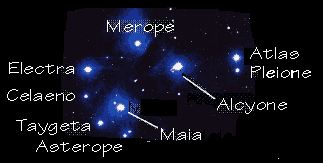 Bill Arnett's map of M45, the Pleiades. This is an open cluster of stars, located in NW Taurus, some of whose members are visible to the naked eye. A finder scope, or binoculars does best with this object. Many photos, like this one, show blue reflection nebulosity around some of the stars, most prominently near Merope. Many people have claimed to see these faint wisps in their own telescope. Such claims should be taken with a slight grain of salt. The stars shine brilliantly and accent any dew on the eyepiece. Bill Arnett's map of M45, the Pleiades. This is an open cluster of stars, located in NW Taurus, some of whose members are visible to the naked eye. A finder scope, or binoculars does best with this object. Many photos, like this one, show blue reflection nebulosity around some of the stars, most prominently near Merope. Many people have claimed to see these faint wisps in their own telescope. Such claims should be taken with a slight grain of salt. The stars shine brilliantly and accent any dew on the eyepiece.
|
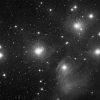 47k JPEG. Image from the Digital Sky Survey. Click here for a 166k JPEG. 47k JPEG. Image from the Digital Sky Survey. Click here for a 166k JPEG.
|
If you have any questions about the Hawaiian Astronomical Society
please
(link requires javascript).